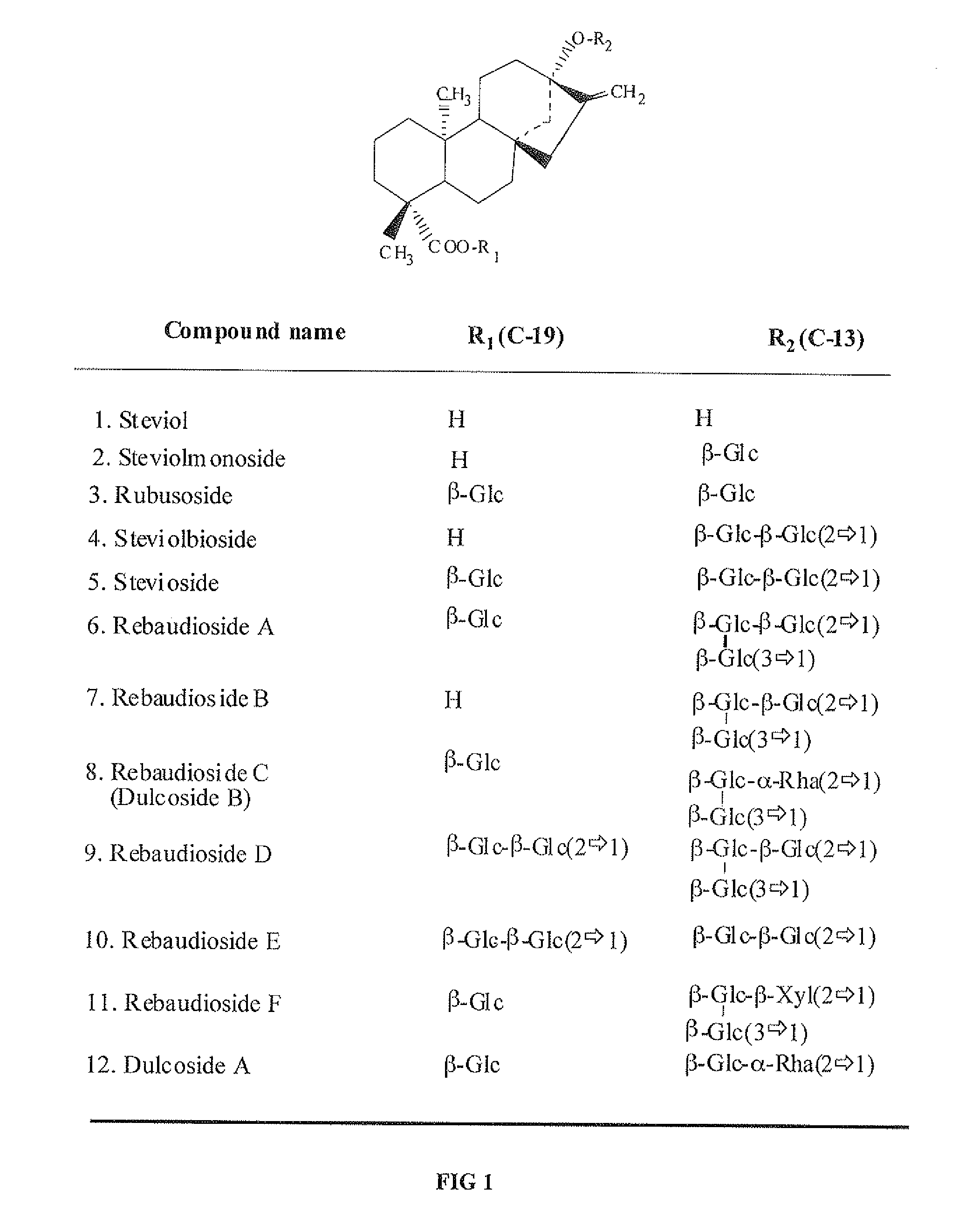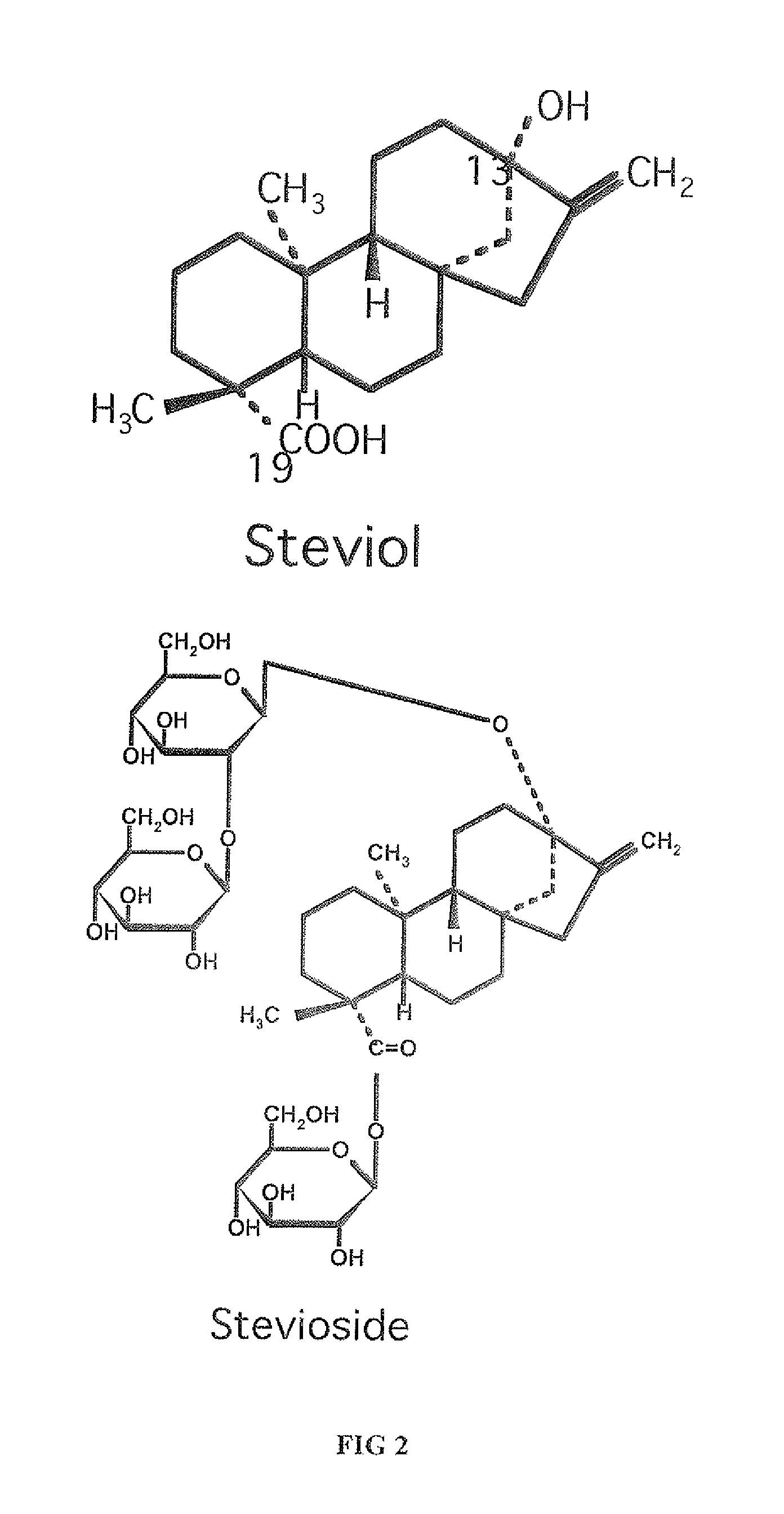Because of these differences, usage of high-
potency sweetener in replacing such a bulk sweetener as
sugar in a food or beverage causes an unbalanced temporal and / or
flavor profile.
The competition among
sugar and non-
sugar high-
potency sweeteners is tough in soft drinks industry, in countries where their use and production is permitted and also in countries with overvalued sugar prices.
In addition, there is
consumer interest in beverages and other beverage products, such as beverage concentrates, whose formulations make greater use of natural ingredients, that is, ingredients distilled, extracted, concentrated or similarly obtained from harvested plants and other naturally occurring sources, with limited or no further
processing.
The development of new beverage formulations, for example, new beverage formulations employing sweeteners, flavorants,
flavor enhancing agents and the like, presents challenges in addressing associated bitterness and / or other off-tastes.
In addition, such challenges typically are presented in new beverage formulations developed for improved nutritional characteristics and / or
flavor profiles.
The method is very complicated with the usage of toxic organic solvents.
The major drawbacks were the use of various toxic solvents to extract and process sweet glycosides.
Process is not environmentally-friendly and difficult to carry out in the large scale.
The process is difficult to apply on commercial scale.
The
disadvantage is that the final product has quite low purity.
However
direct treatment of the leaves required a great quantity of starting material so that the use of leaves was non-economical even when increasing the
bulk density of the dried or comminuted leaves by pressing into
pellets prior to the extraction.
The treatment of powdered extract, which was obtained from leaves by conventional method, allowed the removal of taste-impairing components only to a lesser degree, and without employing entrainers (low molecular weight alcohols, suitable
hydrocarbon or mixture of the solvents) achieves not entirely satisfactory results.
Moreover, there are no quantified data on the actual purity of extract.
The process is difficult to apply on commercial scale.
The major drawback of the method is the low quality of extract.
Treatment with
ion-exchangers and specific adsorbents only, cannot result in high quality
Stevia extract with white color and high content of
steviol glycosides.
The provided method is suitable for production of
Stevia extract with various content of Stevioside but not for highly purified
steviol glycosides.
In the case of use
ethanol with various amounts of water as
crystallization solvent the yield of
Rebaudioside A was in the range 39.6%-76.4% from starting material containing 80.37% Rebaudioside A. The process used the mixture of two organic solvents, which
recovery and purification in large scale was very complicated.
However the method of improving the purity of Rebaudioside A from 79% to 90.2% is not available.
The major drawback of the process is low yields of the final highly products, which makes the process not suitable for commercial production of highly purified Stevioside and Rebaudioside A.
Treatment with only
ion-exchangers and adsorption /
desorption is unable to result in high quality extract.
The molecular weights of sweet glycosides and sterebins are very close and membrane systems cannot result satisfactory resolution of these compounds, which will affect to the purity of extract.
Such treatment will result in yellow
powder with apparently low content of sweet glycosides.
Treatment with only non-polar synthetic adsorbent is unable to result in high quality extract; no measures are taken for residual salts and the color of the product.
From concentrated solution using CaCl2 most of impurities cannot be removed.
Purification process using the n-
butanol extraction is difficult to apply on commercial scale.
This process is unable to result in extract free from salts and other low-molecular weight impurities.
The process is unable to result in extract free from salts and other low-molecular weight impurities.
Most of impurities cannot be removed from concentrated solution using salts.
The treatment is not suitable to remove low-molecular weight impurities.
Process is difficult to apply on commercial scale.
However, used hazardous solvents, can remain in the final product.
Process is difficult to apply on commercial scale.
However, salts content in the final product can be high.
The main drawbacks are that
salt content in the final product can be high, there are no decolorizing and additional purification stages, and, as a result,
steviol glycosides content in the final product can be low.
The major drawback of the method is the low quality of extract.
The treatment with alkali and
ion-exchangers only is not enough to produce the Stevia extract with white color and high content of steviol glycosides.
However, the content of residual salts can be high; there is no decolorizing stage; extraction with n-
butanol and recrystallization from
methanol is not viable commercially.
However, hazardous solvents are used, which can present in the final product.
Process is difficult to apply on commercial scale.
Method can result to the purified Stevioside and Rebaudioside A; however the quality of extract can be low because of the absence of deionization and decolorizing stages.
The main drawback is that hazardous
solvent is used, which can present in the final product.
Process is difficult to apply on commercial scale.
However, the extract quality can be low because of high content of salts and low-molecular weight compounds.
However, the extract quality can be low because of high content of salts and low-molecular weight compounds.
However, the process is difficult to commercialize; salts quantity used for the purification of extract is high and there are no deionization and decolorizing stages.
However, hazardous solvents are used, which can present in the final product.
Process is difficult to apply on commercial scale.
Thirdly, the eluted solution was concentrated and dried to give a powdery material.
However there are no data about the purity of the extract and the
recovery of steviol glycosides.
Low temperatures during extraction increased the operational cost of the production.
These both (low temperatures and pH) resulted in large amount of diluted initial extract.
These factors are substantially increasing the production cost and decreasing the yield of final product in
unit of time.
However, there are no data on the steviol glycosides content in the final product.
Obviously only this type of treatment cannot result in highly purified extract, especially because of polysaccharides,
heavy metals and sterebins, which remain in clarified extract.
Moreover, no data about half-life and adsorption capacity of the carrier which is very important when process is carried out in continuous conditions.
The
system Stevia+CO2+water was able to remove approximately 50% of the original Stevioside and about 72% of Rebaudioside A. The main drawbacks of the method are the requirement of
high pressure and low extraction rate of sweet compounds.
The process is difficult to apply on commercial scale.
An increased temperature resulted in significant degradation of Stevioside in the media of both solvents or in a decline in the extraction yield in water.
The method is unable to result in high purity Stevia extract.
Purification process is difficult to apply on commercial scale.
All the existing methods deal with isolation and purification of one or other
steviol glycoside from the initial extract and do not show a way for the further treatment of residual solution or purification of minor compounds.
However, there is no published data on the commercial isolation and purification of Rebaudioside D which possess excellent sensory properties.
Rebaudioside D content in the extract is very low and because of that its purification is very difficult.
 Login to View More
Login to View More  Login to View More
Login to View More 


